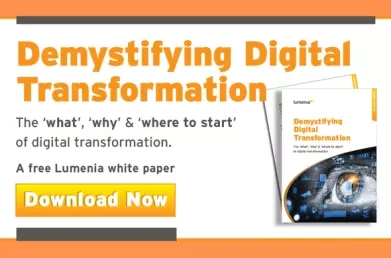Successful Digital Transformation Planning: 10 Tips for Balancing Ambition & Pragmatism
Having recently completed a digital transformation strategy project with one of our clients, I have found myself reflecting on the process we went through to develop their transformation roadmap. While it's important to “think big” when envisioning a more digitally-enabled future for your business, it's crucial to balance ambition with pragmatism during the planning phase.
Drawing on my first-hand experience, and building on the insights shared in my previous article on 'Getting Started with Digital Transformation,' here are my top ten tips for successful transformation planning. These should help you strike the right balance and set yourself up for transformation success:
1. Prioritise Projects
Assess and prioritise digital transformation projects based on their strategic importance and potential to deliver the greatest business benefits (e.g. process efficiencies, risk reduction, cost savings and improved customer service).
2. Assess Your Resources
Be realistic about your organisation's capacity and capabilities to undertake digital transformation initiatives (e.g. project management, business analysis, solution architecture and information security skills). Consider enlisting outside help to train or bolster the team.
3. Align with Budgetary Realities
Ensure that your digital transformation initiatives are financially viable, considering both immediate and long-term costs, and be prepared to make trade-offs. This financial grounding will help you to create a roadmap that's achievable.
4. Foundational Initiatives
Before diving into major technology projects, ensure that you have the necessary foundations in place, such as suitable organisational and governance structures, IT infrastructure and security, and project management disciplines.

5. Quick Wins
Include "quick win" initiatives on your digital transformation roadmap to demonstrate early success (e.g. small-scale improvements and enhancements to existing systems and reports). This will not only build internal buy-in and momentum but also boost your team's confidence in their ability to execute larger, more complex projects.
6. Mitigate Change Fatigue
Understand your people's threshold for change and design your transformation plan to minimise burnout. Implement change gradually, maintain open lines of communication and provide practical support to help your team embrace the programme with confidence.
7. Contingency Planning
Build in gaps and contingency time between projects on your roadmap to accommodate unforeseen challenges and allow for flexibility in managing your digital transformation initiatives.
8. Competing Priorities
Identify other significant changes that your organisation is likely to undergo during the same period as your digital transformation programme and try to ensure that these don't strain or distract key project resources.
9. Agile Planning & Adaptation
Plan in more detail for initiatives appearing in the first year on your roadmap, as they will likely have the highest degree of certainty and alignment with current business objectives. As you plan for subsequent years, acknowledge that priorities and circumstances may change, and be prepared to adapt your digital transformation plan accordingly.
10. Continuous Learning & Adaptation
Embrace a culture of continuous learning and improvement throughout your digital transformation journey. Encourage feedback from employees and stakeholders through regular surveys, focus groups and/or check-ins, and be willing to adapt your strategy as you learn from your successes and setbacks.
By balancing ambition and pragmatism, prioritising initiatives and building a solid foundation for change, you can position your business for long-term success in the digital age. Remember that your organisation will evolve over time and your digital transformation plan should be flexible enough to accommodate changing business priorities.
Find Out More
This blog was written by Principal Consultant Edward Abrahamson. Visit our digital transformation services page for information on how we can help, or reach out to Edward directly.


